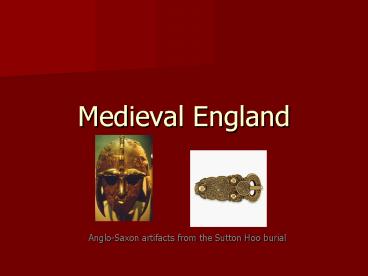Medieval England - PowerPoint PPT Presentation
Title:
Medieval England
Description:
Medieval England Anglo-Saxon artifacts from the Sutton Hoo burial The Middle Ages Called this because it s just the period stuck between the collapse of the ... – PowerPoint PPT presentation
Number of Views:70
Avg rating:3.0/5.0
Title: Medieval England
1
Medieval England
- Anglo-Saxon artifacts from the Sutton Hoo burial
2
The Middle Ages
- Called this because its just the period stuck
between the collapse of the Roman Empire (around
470 AD) and the Renaissance (15th Century) - The early centuries of this period are sometimes
seen as having nothing of importance to offer in
terms of advancement in society.
3
The Middle Ages
- Also called The Dark Ages because of a
perceived lack of literacy and slow advance of
learning. - This is an inaccurate assumption.
- While its true that the common person was
illiterate, a great deal of knowledge was
preserved in monasteries, particularly in the
British isles.
4
The Celts
- Prior to Roman colonization, the British isles
were settled by Celtic tribes such as the
Britons, Picts, and Scots - They spoke various forms of Gaelic
- Tribes often fought amongst themselves for
territory and power
5
The Celts
- Most tribes were pagan and their religious
leaders were called druids - Some had been converted to Christianity under the
Romans but the new Christian theology was often
mixed with the older pagan tradition
6
The Romans
- When the Romans annexed Britain, they brought a
great deal of stability - Although they were at times brutal rulers, Roman
governors could easily repel other groups trying
to invade the islands
7
The Invasions
- After the fall of the Roman Empire, mass chaos
ensued - Celtic tribes were left virtually powerless to
protect themselves against invaders - Seafaring warriors from the area of Europe which
is now northern Germany and Denmark began
attacking the Britons
8
Anglo-Saxon Origins
9
The Invasions
- These tribes (Angles, Saxons, and Jutes) were
successful in pushing the native Britons out of
most of England - Celtic tribes retreating to the areas around the
edges Wales, Scotland, and Ireland (which
accounts for differences in language and culture
today)
10
(No Transcript)
11
Anglo-Saxon Life
- After the invasion, they settle into a fairly
peaceful agricultural lifestyle (with the
occasional blood-feud against neighboring clans,
of course).
12
Anglo-Saxons
- The Anglo-Saxons practiced a different pagan
faith than the Celts. - Their primary god was named Wodin and their gods
myths are similar to those of the Vikings - Missionaries from Ireland converted many to
Christianity in the 6th century - But again, in those early years theologies blend
together and overlap
13
Anglo-Saxon Literature
- With the rise of Christianity in England,
literacy rose again. - People, especially monks, wrote about religious
subjects, mostly in Latin - Some poetry is written in Old English, the
language of the Anglo-Saxons and was then copied
and preserved by monks
14
Manuscript Illumination
15
Anglo-Saxon Poetry
- Anglo-Saxon poetry was originally an oral
tradition - It would be memorized by story tellers who would
travel around and retell them in exchange for
food, shelter, etc. - These people were highly revered because of the
heroic stories they shared
16
Anglo-Saxon Poetry
- Alliteration the repetition of consonants within
a line of poetry - Caesura breaks or pauses in the middle of a line
- Kenning compound words that describe something
and are used instead of the actual name - These aspects create a predictable, even hypnotic
rhythm in the original language
17
Beowulf in Old English
- Stid ond styl-ecg strenge getruwode,
- mundgripe mægenes. Swa sceal man don
- Þonne he æt gud gegan Þenced
- longsumne lof
- (line 1533-1536)
18
Beowulf in Translation
- hurled the steel-edge his strength must be
- in his mighty hand-grip. So must a man do
- who intends to gain long-lasting glory
- in battle
19
Anglo-Saxon Society
- The basic unit of society was the clan, a group
of people connected by kinship - The leader of the clan was a king or lord
- He would surround himself with warriors who had
sworn loyalty to him - They were duty bound to fight to the death for
him, whenever he asked.
20
The Role of the Lord
- In return, he provided them with food, mead,
shelter, and social interaction in his great hall
21
The Role of the Lord
- The king was bound by duty and honor to reward
his warriors with gold for the services they
provided him - Poetry of the time condemns lords who are stingy
with gold and praises those who give freely
dat wæs gud könig
22
Beowulf in Context
- The story of Beowulf is set within this context
of lord and retainers coexisting in the meadhall. - Beowulf begins as a young warrior, looking to
prove his worth by accomplishing great and heroic
deeds. - He eventually earns a crown for himself and must
become a good and generous king.
23
For Further Online Reading
- http//www.phancocks.pwp.blueyonder.co.uk/localhis
tory/AS20farmstead.jpg - www.mylearning.org/image-zoom.asp?jpageid701...
- www.florin.ms/aleph4.html





























![⚡[PDF]✔ Humour in Old English Literature: Communities of Laughter in Early Medieval PowerPoint PPT Presentation](https://s3.amazonaws.com/images.powershow.com/10067249.th0.jpg?_=20240628046)
![⚡[PDF]✔ Humour in Old English Literature: Communities of Laughter in Early Medieval PowerPoint PPT Presentation](https://s3.amazonaws.com/images.powershow.com/10068150.th0.jpg?_=20240629047)
![read [pdf] medieval warfare: a history PowerPoint PPT Presentation](https://s3.amazonaws.com/images.powershow.com/10141141.th0.jpg?_=20240927044)